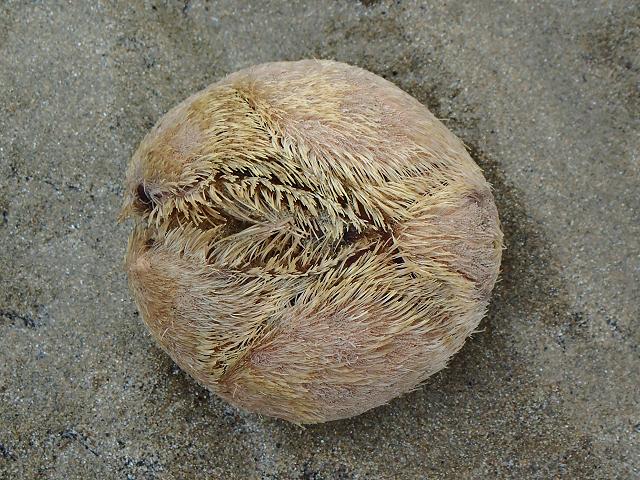
APHOTOMARINE
An educational resource dedicated mainly to the photography
and diversity of marine life that can be found in coastal waters
and intertidal areas of Great Britain and Ireland by David Fenwick.

Echinocardium cordatum (Pennant, 1777) - Sea Potato (Sea urchin images)
Scroll down and rollover titles to change screen image or click on title to view image.
Sea Potato
Echinocardium cordatum
- dorsal view live animal 1
Echinocardium cordatum
- dorsal view live animal 1
Sea Potato
Echinocardium cordatum
- dead animal / test 1
Sea Potato
Echinocardium cordatum
- dead animal / test 2
Sea Potato
Echinocardium cordatum
- dead animal / test 3
Sea Potato
Echinocardium cordatum
- dead animal / test 4
Specimens found washing in on the low tide mark at Chyandour Rocks, Penzance, Cornwall, 25.08.18.
Sea Potato
Echinocardium cordatum
- dorsal view 1
Sea Potato
Echinocardium cordatum
- ventral view 1
Sea Potato
Echinocardium cordatum
- collection / group of 1
Sea Potato
Echinocardium cordatum
- hidden under sand 1
Specimens above found at entrance of Penzance Harbour, Albert Reef, Penzance, Cornwall.
Sea Potato
Echinocardium cordatum
- pluteus larva (planktonic) 1
Sea Potato
Echinocardium cordatum
- pluteus larva (planktonic) 2
Sea Potato
Echinocardium cordatum
- pluteus larva (planktonic) 3
Sea Potato
Echinocardium cordatum
- postmetamorphic larva 1
Sea Potato
Echinocardium cordatum
- postmetamorphic larva 2
Sea Potato
Echinocardium cordatum
- postmetamorphic larva 3
Specimens above caught in a plankton net at Newlyn Marina, Newlyn, Cornwall, 13.06.17 and 10.07.17.
Sea Potato
Echinocardium cordatum
- spine 1
Sea Potato
Echinocardium cordatum
- spine close-up 1
Sea Potato
Echinocardium cordatum
- spine under microscope 1
Sea Potato
Echinocardium cordatum
- spine under microscope 2
Sea Potato
Echinocardium cordatum
- live / dorsal view 1
Sea Potato
Echinocardium cordatum
- live / ventral view 1
Sea Potato
Echinocardium cordatum
- live / dorsal view 2
Sea Potato
Echinocardium cordatum
- live / ventral view 2
Sea Potato
Echinocardium cordatum
- live / ventral view 3
Sea Potato
Echinocardium cordatum
- live / posterior view 1
Sea Potato
Echinocardium cordatum
- live / freshly dug 1
Sea Potato
Echinocardium cordatum
- with Tellimya ferruginosa 1
Sea Potato
Echinocardium cordatum
- with Tellimya ferruginosa 2
Sea Potato
Echinocardium cordatum
- with Tellimya ferruginosa 3
Sea Potato
Echinocardium cordatum
- test from Hayle 1
Sea Potato
Echinocardium cordatum
- test from Hayle 2
Sea Potato
Echinocardium cordatum
- test from Hayle 3
Sea Potato
Echinocardium cordatum
- test / top view 1
Sea Potato
Echinocardium cordatum
- test / top view 2
Sea Potato
Echinocardium cordatum
- test / top view close-up 1
Sea Potato
Echinocardium cordatum
- test mouth / underside 1
Images of species taken at various locations across the south coast of Cornwall; the best place to find this species is at Par, near St. Austell, Cornwall, where tests can be found in large numbers on the strandline after storms, and where live animals can similarly be found washed up on the lowershore. Species can also be found in Mounts Bay from Newlyn to Marazion.
Species also found in soft sediment on the lowershore at Batten Beach, Mount Batten, Plymouth, Devon; by Dr. Keith Hiscock of the Marine Biological Association, and at the MBA Batten Bay Bioblitz 2014. 12.09.14. Species lives under sand, species can be found by looking for two small holes on the surface of sand, a few inches apart. The species also has a commensal bivalve, Tellimya ferruginosa, Rusty montagu shell, that can be found close to the anus of the species, as seen in the images above.
Scientific and European Names:
Echinocardium cordatum, Sea Potato, Seeigel herzigel, Zeeklit, Oursin coeur, Erizo corazon, Spatango a forma di cuore.

The main objective of this website is in furthering environmental awareness and education through the medium of photography. To increase awareness and access to the wildlife of the region and help
people find and identify it. Sometimes the difference between species is obvious but many species can only be determined by observing microscopic characteristics that are specific to any one species.